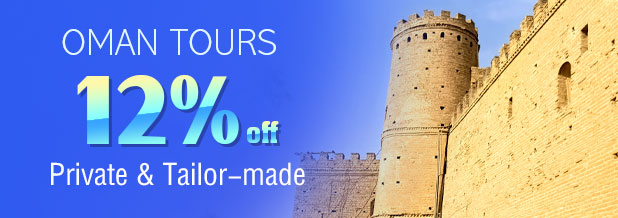- Top Things to Do
- Transportation
- Transportation
Top Things to Do in Oman
Top Destinations
1. Muscat
Oman is located along the southeastern coast of the Arabian Peninsula. Muscat in northeast Oman is the capital and the largest city of it. Muscat connects the Persian Gulf and the Indian Ocean, surrounded by mountains on three sides. To its southeast and northeast respectively are the Arabian Sea and the Oman Bay. Muscat boasts many places of interest, such as Sultan's Palace, Sultan Qaboos Grand Mosque, Al Jalali Fort, Al Mirani Fort, and Wahiba Sands.2. Salalah
Salalah, located in Dhofar Province, is the second largest city and the southernmost city of Oman. It is a seaside resort city in the Gulf region, which is traditionally known as an incense production. Salalah Tourism Festival began in 1997 and then gradually became the region's annual grand celebration. It's held in the Folk Village Park and lasts nearly two months. To promote traditional culture, folk culture performances, handicrafts shows, sports competitions, and trade fairs are held in the festival. In Salalah, you can taste the secret history and enjoy the beautiful scenery in Al Baleed Archaeological Site, Marneef Cave and Blow Holes, and Sultan Qaboos Mosque.
3. Nizwa
Nizwa, the ancient capital of Oman, is about 130 kilometers (81 miles) west of Muscat and lies on the southwest of Jebelat Akildar Grasslands. The soil is fertile and it has many fountains. You can visit Nizwa Fort, one of the biggest forts in Oman which was built in 1668. If you want to experience the local life and buy gifts, you can go to Nizwa Souq. Here you can buy handicrafts and local fruits.
4. Seeb
Seeb is a coastal city in the northeastern part of Oman and has the main civil airport in the country. The landmarks include the Naseem Garden, the Royal Stables and Equestrian Center, and Seeb Palace.
Top Attractions
1. Al Alam Palace
Al-Alam Palace, located in the old town of Muscat, is the presidential palace of the Sultan. Beautifully built and complete with modern equipment, this ancient palace adds a modern light to the old town. But it is a ceremonial palace; the Sultan does not live here. The palace has more than two hundred years of history. It was originally built by Imam Sultan bin Ahmed and then was rebuilt as a royal residence. The Palace is surrounded by the Mirani and Jalali Forts. Visitors are not allowed to enter, but only take photos near the gate.
2. Sultan Qaboos Grand Mosque
Sultan Qaboos Grand Mosque is the third largest mosque in the world and the main mosque in Oman. In 1992, Sultan Qaboos decided to build a Grand Mosque for Oman. The construction began in 1995 and finished in 2001. The mosque covers an area of 41.6 hectares (102.8 acres), of which the main building area is 4 hectares (10 acres).In addition to the two prayer halls, the mosque includes an Islamic Institute, a three-storey library with 20,000 books and a conference hall with 300 seats.
3. Fort Al Jalali and Fort Al Mirani
Fort al-Jalali lies on the harbor of Old Muscat, Oman. Visitors are not permitted to enter, except heads of states. In the 1580s, the Portuguese established this building to defend the Ottoman invasion, and then it was used as a refuge or prison for royal members in the 1970s. Fort al-Jalali was rebuilt in 1983 and became a private museum housing many precious exhibits, including cannons, rugs and other handicrafts.Fort Al Jalali and Fort Al Mirani are usually called twin forts. Built on another rock, Fort Al Mirani is on the opposite side of Fort Al Jalali. Visitors are not allowed to enter, but they can take photos from the outside.
4. Al Baleed Archaeological Site
It is an archaeological museum located in the southeast corner of Salalah. In addition to the archaeological site, there are two museums on Oman's history.
5. Nizwa Fort
Nizwa Fort was built in 1668 and is the most famous historical building in Nizwa. The fort is now a museum with a variety of dark rooms and battlements. It is also one of Oman's oldest and largest forts, regarded as the symbol of Oman's great history.Food
The country's culinary traditions are influenced by Arabian and Indian food. Cafés and restaurants are main places to eat. Cafés are the basic eating venue and cost less. Restaurants have good environment and wider range of cuisines, such as Indian, Chinese and European dishes. You can also taste spit-roasted chicken and Lebanese and Turkish-style grilled kebabs.
You cannot miss the traditional dessert Halwa. Ingredients of Halwa include semolina, sugar, butter and rose-water. During the cooking, cardamom and almonds are added. But it is different from Halwas in Europe, the Middle East and Asia. Besides, you can buy dates. Dates are an Omani staple, representing hospitality.
Outdoor Activities and Sports
Oman is the paradise for visitors to join in outdoor activities and sports due to wild mountains and desert landscapes.
Hiking:
Hiking is the most rewarding outdoor activity. Oman, especially in the Western Hajar, has plenty of hiking trails. You may surmount big rocks, rock pools and rivers. You should carry enough water and keep an eye on the weather changes.Adventure sports:
You can do canyoning, caving, abseiling, rock-climbing, mountain-biking and kayaking. You can choose the Muscat Diving & Adventure Centre or Gulf Leisure to participate in these activities.Diving and snorkeling:
With pristine underwater landscapes and marine lives, Oman is an ideal destination for diving. You can experience diving and snorkelling. Musandam is the best diving place in Oman. The coastal waters are unpolluted, and have coral gardens and wrecks. You have an extensive selection of dive centers and can obtain a standard range of dives together with PADI courses.
Further Reading:
Oman Transportation Useful Travel Tips

